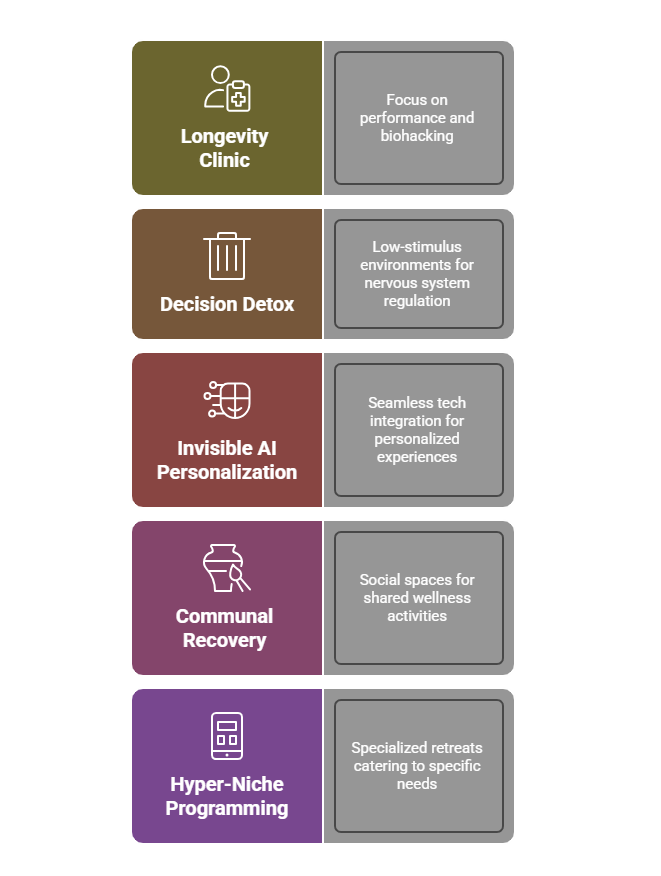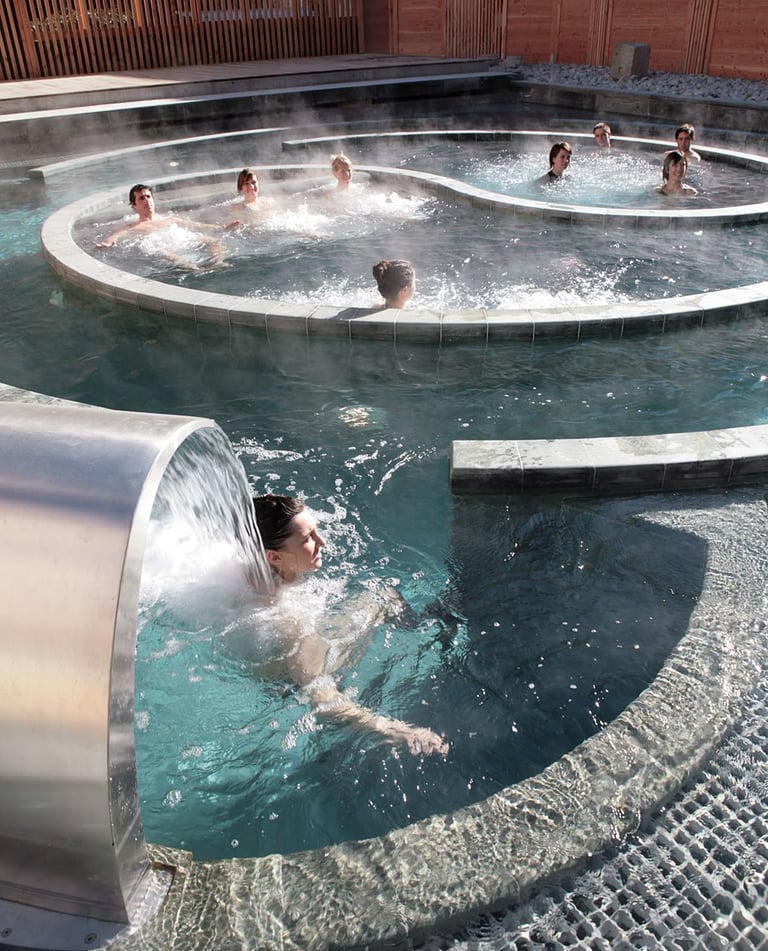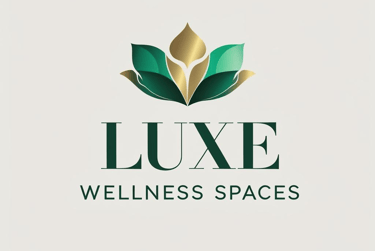Luxury Wellness Trends 2026: 5 Operational Shifts Defining High-End Hospitality
Discover the 5 critical luxury wellness trends for 2026. Move beyond standard spas to longevity, AI, and communal recovery. Future-proof your hotel asset today.
Daryn Berriman
11/7/20258 min read


If your development strategy for a 2026 opening relies solely on a beautiful infinity pool and a standard Swedish massage menu, you are already falling behind. The ultra-high-net-worth traveler currently booking their future stays is no longer impressed by basic amenities; they are demanding a fundamental shift in how you deliver well-being.
What are the key luxury wellness trends for 2026?
Luxury wellness in 2026 will shift from passive relaxation to active, metric-driven performance. Successful properties will integrate medical-grade longevity diagnostics, "invisible" AI personalization, and high-touch communal recovery spaces directly into the guest journey. According to recent data, 70% of travelers have already increased their spending on longevity-related services, signaling a massive departure from traditional spa offerings.
Why It Matters: The Commercial Stakes
Ignoring this shift has tangible consequences for your asset value and Average Daily Rate (ADR). We are currently witnessing legacy "luxury" resorts lose market share to agile new market entrants who bake wellness into their entire operational model, rather than treating it as a basement amenity.
The financial imperative is clear. The Global Wellness Institute (GWI) projects the total wellness economy will reach a staggering $8.5 trillion by 2027. More specifically, the longevity market within hospitality is projected to grow at a Compound Annual Growth Rate (CAGR) of 10.8% through 2033. If your property cannot prove a measurable ROI on a guest's well-being, they will simply move to a competitor that can.
The 5 Strategic Shifts for 2026
To stay competitive, your forward-looking strategy must account for these five conceptual and operational shifts.
1. The Longevity Clinic Replaces the Day Spa
Guests now often have access to better biohacking tools at home (from Oura rings to infrared saunas) than most five-star hotels offer. To impress them in 2026, you need to level up from "pampering" to "medical-grade integration."
This trend requires a complete rethink of your staffing model and floor plan. We are advising clients to move beyond just massage therapists and toward hiring nurse practitioners or partnering with functional medicine clinics. The modern luxury guest wants to know their biological age, not just get a facial.
Operational Deep Dive: Transitioning to longevity is capital intensive but yields higher margins.
Space Requirements: You need less "vibe" and more clinical efficiency. Think consult rooms with phlebotomy chairs rather than just dimly lit massage rooms.
Staffing: You cannot run a longevity clinic with standard estheticians. You need a Medical Director (often outsourced) to oversee protocols, ensuring you are legally compliant to offer services like IV drips or prescription-grade peptides.
Key Offerings: On-site blood diagnostics, NAD+ IV vitamin infusions tailored to real-time biomarker data, and hyperbaric oxygen therapy chambers.
The Goal: Extending a guest's "healthspan" (years lived in good health), not just helping them relax for an hour.
2. The "Decision Detox" Concept
Cognitive overload is at an all-time high, especially for the C-suite demographic that frequents luxury properties. For these guests, true luxury in 2026 will be the complete absence of choice.
The "Decision Detox" involves hyper-curated, all-inclusive wellness itineraries where the guest surrenders all control. Every meal, treatment, and movement session is pre-planned based on an initial intake before they even arrive. They don't want to look at a menu; they want you to know what they need.
Operational Deep Dive: This trend relies heavily on pre-arrival operational excellence.
The Intake: Your reservations team needs to be trained as wellness concierges. They must capture data on sleep patterns, dietary stressors, and current physical state weeks before arrival.
F&B Integration: The kitchen must be synced with the spa. If a guest is on a "Deep Rest" protocol, the chef automatically prepares dinners high in tryptophan and magnesium, without the guest having to order it.
Design Implication: We are designing "low-stimulus" zones; spaces with neuro-aesthetic principles that actively downregulate the nervous system through specific circadian lighting, advanced sound dampening, and minimalist, biophilic design.
3. Communal Recovery Over Solitary Silence
While privacy remains a hallmark of luxury, a massive shift is happening toward social wellness. The lonely, silent spa corridor is being supplemented (and in some cases replaced) by vibrant, communal recovery spaces.
Driven by a desire for connection in an increasingly isolated digital world, guests are seeking shared healing experiences. This is the "Third Place" concept applied to wellness, a social hub that isn't a bar or a lobby.
Operational Deep Dive: Financially, communal recovery is a powerhouse because it increases throughput.
Revenue Per Square Foot: A standard massage room services one guest per hour. A 1,000 sq ft contrast therapy zone (sauna, ice baths, recovery lounge) can service 15-20 guests per hour at a lower price point per head, but a much higher aggregate revenue.
The New Anchor: Large-scale contrast therapy circuits designed for groups. Think stadium-seating saunas that can host guided breathwork sessions.
Ancillary Spend: These spaces drive higher F&B spend. Guests finishing a social sauna session naturally gravitate toward an adjacent recovery bar for functional beverages, turning a non-revenue-generating relaxation area into a vibrant profit center.
4. Invisible AI Personalization
There is a fear in hospitality that Artificial Intelligence will make experiences feel robotic. In 2026, the opposite will be true: the best AI will be completely invisible, making the stay feel more human.
Differentiation will be in how seamlessly tech is integrated. It’s not about a robot delivering room service; it’s about predictive backend systems that empower your staff. Statistics show that nearly 60% of travelers are willing to pay extra for amenities and services that are personalized to them.
Operational Deep Dive: The challenge here is breaking down data silos between your Property Management System (PMS) and your Spa/Wellness software.
The Application: Imagine a system that knows a guest is arriving from a timezone 8 hours away. The AI automatically adjusts their room's circadian lighting protocols to help them adapt, pre-sets the calm-inducing temperature, and schedules a light therapy session for the next morning, all before they check in.
Staff Empowerment: The AI should prompt your front desk staff: "Ms. Smith just finished a high-intensity Peloton ride in the gym; suggest the magnesium recovery bath when she walks by."
The Result: Frictionless personalization that anticipates needs without the guest ever having to ask.
5. Hyper-Niche Life-Stage Programming
The "something for everyone" resort model is fading. It often results in a bland experience that compels no one. The highest ROI in 2026 will come from specialized, deeply relevant programming that targets specific life stages.
By 2026, over 1.1 billion women globally will have experienced menopause, yet very few luxury properties cater specifically to this massive market with high disposable income.
Operational Deep Dive: Niche programming requires genuine expertise, not just marketing fluff.
Menopause Retreats: These aren't just standard yoga retreats labeled differently. They require clinically backed programs featuring endocrinologist consultations, cooling bedding and sleep-tech in rooms, and nutritional menus designed to stabilize hormones.
Executive Burnout Recovery: High-intensity reset programs for leaders that might include neurofeedback sessions and aggressive sleep retraining.
Neurodivergent-Friendly Travel: Spaces specifically designed for sensory regulation, catering to affluent families who need predictable, low-sensory environments for their children. When you solve a specific, acute problem for a wealthy guest, price sensitivity decreases significantly.


The Costly Mistake Most Operators Make
The most common error we see in our operational audits is CapEx without OpEx Strategy.
Properties spend millions on trendy hardware (cryo chambers, red light beds, sensory deprivation tanks) without investing in the specialized staff or programming to make them usable. Equipment quickly becomes an expensive coat rack if it isn't part of a cohesive, expert-led journey.
Don't build a longevity wing if you aren't prepared to hire the medical director required to run it legally and safely.
Another critical mistake is underestimating payroll. High-touch, specialized wellness requires higher-paid, more qualified staff. If your pro-forma is based on standard therapist wages for a functional medicine program, your operational budget will fail in Year 1.
How 2026 Wellness Compares
Here is the fundamental shift in operational mindset required for the next three years:
The 2020 Model: Spa is a siloed amenity in the basement.
The 2026 Model: Wellness is integrated into every touchpoint (room air quality, F&B, sleep tech).
The 2020 Model: Menu of à la carte services (Swedish massage, standard facial).
The 2026 Model: Outcome-driven programs (Sleep Restoration, Cognitive Performance, Hormone Balancing).
The 2020 Model: Focus on relaxation and indulgence.
The 2026 Model: Focus on longevity, recovery, and measurable biological data.
The Counter-Intuitive Truth About Tech
Many luxury operators resist high-tech wellness because they believe true luxury must be "high touch, low tech."
The counter-intuitive truth for 2026 is that high tech enables high touch.
By using AI and data to handle routine preferences, scheduling, and biomarker tracking, you free up your highly trained human therapists and concierges to do what only they can do: provide deep emotional connection and empathetic care. Technology shouldn't replace your staff; it should give them superpowers to serve guests better, faster, and more personally.


These trends are not just marketing buzzwords; they represent a fundamental maturity in the wellness market. Guests are smarter, more demanding, and willing to pay significantly more for experiences that deliver tangible results.
Adapting your property for 2026 requires more than a renovation budget. It requires a strategic reimagining of your entire guest journey.
Is your current development roadmap ready for the 2026 traveler? Book a strategic concept audit with Luxe Wellness Spaces today and ensure your asset is future-proof.
FAQ's
Q: What is the biggest wellness trend for hotels in 2026? A: The most significant trend is the shift from "pampering" to "longevity" and performance. Guests now expect medical-grade services, advanced diagnostics, and treatments that measurably improve their long-term healthspan, rather than just simple relaxation massages.
Q: How does a traditional spa compare to a longevity clinic in hospitality? A: A traditional spa focuses on immediate relaxation through external treatments like massages and facials. A longevity clinic in a hotel focuses on long-term internal health, utilizing blood diagnostics, IV therapies, and highly trained medical staff to deliver measurable health outcomes.
Q: Is investing in social wellness spaces profitable for luxury hotels? A: Yes, social wellness spaces like communal bathhouses often drive higher revenue per square foot than traditional private treatment rooms. They allow for higher guest throughput (multiple people using one facility simultaneously) and significantly increase ancillary spend in adjacent F&B recovery areas.
Q: Will AI replace human therapists in luxury wellness hotels? A: No, AI will not replace human therapists in the luxury sector. Instead, it will handle complex data analysis, personalization preferences, and scheduling in the background, freeing up human staff to focus entirely on delivering high-touch, emotionally resonant guest experiences.
Q: How large is the projected wellness economy for 2027? A: According to the Global Wellness Institute, the worldwide wellness economy is projected to reach approximately $8.5 trillion by 2027, driven largely by growth in wellness tourism and wellness real estate.
Further reading on our blog: Further reading on our blog: 'What "Quiet Luxury" Really Means in Spa Design.'
Learn more about the blog author and our principal consultant at Luxe Wellness Spaces.
Explore our Spa & Wellness Consultancy to scope project phases and services.
See how we structure Fitness and Leisure concepts before you commit to equipment.
Learn why Luxe Wellness Spaces blends design, operations, and growth under one roof.
View a Concept-to-Launch case study that hit break-even in 90 days.
Reference List:
Global Wellness Institute - Global Wellness Economy Monitor 2023 Findings
CoStar - Why longevity is the hospitality industry's next big profit driver
Dataintelo - Longevity Hotel Market Research Report 2033
Sabre Hospitality - 8 game-changing hospitality trends for 2025
Medical Travel Market - Top Wellness Tourism Trends in 2025
About The Author
Daryn Berriman is the Founder and Principal Consultant of Luxe Wellness Spaces, a consulting-led studio blending operational expertise and design excellence to create wellness businesses that perform, and spaces that guests love.


